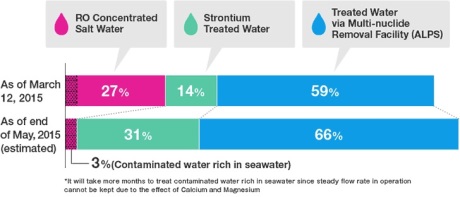Almost all of the contaminated water stored on the Fukushima Daiichi plant site in Japan has been treated to remove strontium, and in some cases even more nuclides, Tokyo Electric Power Company (Tepco) announced today.
The company had originally planned to treat all contaminated water on the site by the end of March 2015, but in January it announced that it would need more time. It attributed the longer time frame to the challenges of implementing new technologies to clean the water and to a "safety first" approach.
"This is a significant milestone for improving the environment for our surrounding communities and for our workers."
Naohiro Masuda,
Tepco chief decommissioning officer
In March, Tepco said its revised schedule called for most of the remaining water to be treated by the end of this month. This includes water that has had strontium and other contaminants removed through the ALPS (Advanced Liquid Processing System) multi-nuclide removal system, as well as water that has already had strontium removed but not the other contaminants. It also includes water that was processed by the ALPS systems whilst they encountered performance issues and which needs to be treated again to further remove contaminants. Together this accounts for 97% of the water stored at the site.
The remaining 3% of the water is that containing relatively high levels of seawater components, such as calcium and magnesium. In the days immediately following the March 2011 accident, the damaged reactors were cooled with seawater until a freshwater system was in place.
Tepco has now announced that almost all of the stored contaminated water at Fukushima Daiichi has now been treated to at least remove the strontium in it.
 |
| Progress in contaminated water treatment (Image: Tepco) |
The company said, although the "high-percentage seawater" accounted for only about 3% of the volume of water stored on the site as of March, it had expected to take longer to treat because of its greater density. However, Tepco said warmer ambient temperatures reduced the water's density and engineers worked out the appropriate flow rate which has enabled all the water to be treated by the new target date.
Tepco said, "The achievement is expected to further contribute to lowering radiation levels within the facility. The treatment had achieved the goal of reducing the radiation dose at the site boundary attributed to water tanks to under 1 millisievert per year in March."
Some of the treated water will require further processing to remove "additional, less problematic nuclides", Tepco noted. However, the company said that the removal of strontium "represents the removal of the substance most likely to contribute to radiation in the environment".
The filters and other equipment components that now contain the strontium will be stored on-site in shielded containers.
The only remaining contaminated water - some 2% of the original volume - is that in the bottom of the storage tanks which cannot be removed using the originally installed pumps. Tepco said that this water would be carefully removed and treated as each storage tank is dismantled in the future.
Tepco chief decommissioning officer Naohiro Masuda said, "This is a significant milestone for improving the environment for our surrounding communities and for our workers. It reduces risk and will make people inside and outside the facility more secure."
Researched and written
by World Nuclear News




_30199.jpg)
_72306.jpg)

_49562.jpg)





